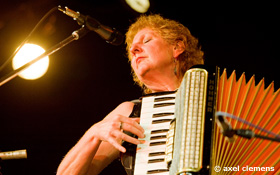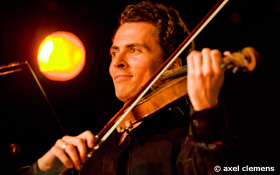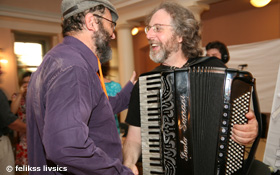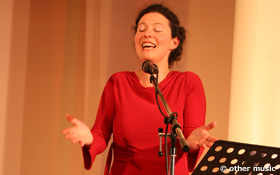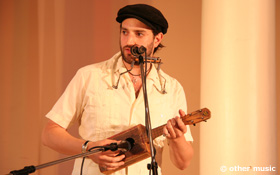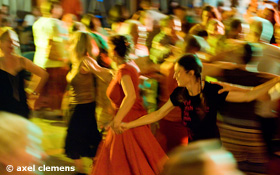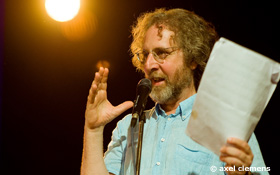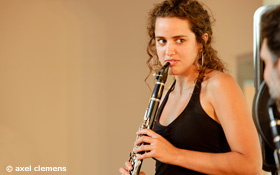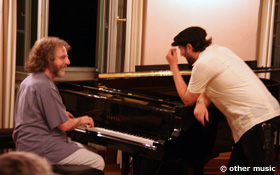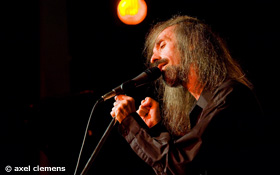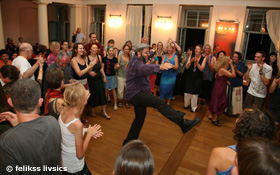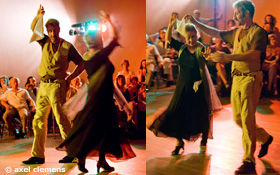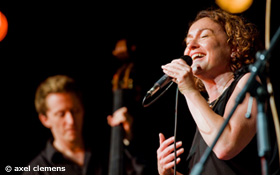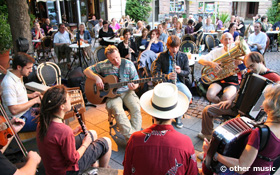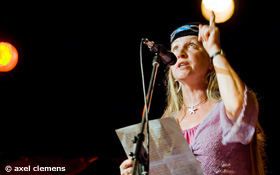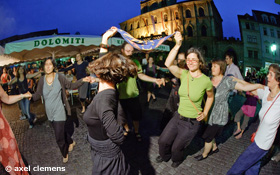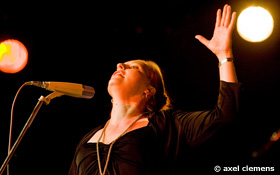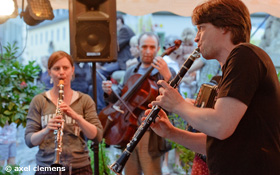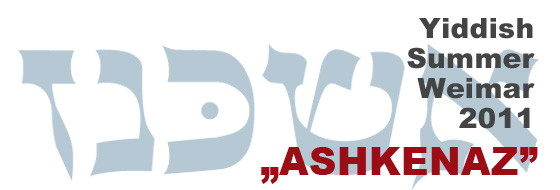Concerts
July 09 20:00@mon ami
Nisht-geherte lider Unheard songs
Song Workshop Faculty Concert
July 16 20:00@Musikschule
Shtromen Currents
Song Workshop Final Concert
July 17 20:00@mon ami
Ensemble Lucidarium – Ain neue Lid: When Yiddish Was Young
The alternation of periods of hostility with those of clemency on the part of the local population, princes and ecclesiastical institutions marked the existence of the Jews who lived in the German-speaking lands from medieval times throughout the Renaissance, and the 16th century was certainly no exception. read more 
The alternation of periods of hostility with those of clemency on the part of the local population, princes and ecclesiastical institutions marked the existence of the Jews who lived in the German-speaking lands from medieval times throughout the Renaissance, and the 16th century was certainly no exception. This continuous cycle of conditioned acceptance, oppression, expulsion (and worse) would not be broken until the enlightenment. Still, despite adversity, there are clear signs of a flourishing cultural tradition, closely entwined with that of the surrounding populations. It was in this era that the seeds of “Yiddishkeit” were sown, of a poetical and musical tradition that has identified an entire people for hundreds of years.
During the 16th Century, favorable conditions in Italy attracted Jews from around Europe, while the relatively peaceful situation in Eastern Europe led to the first major Ashkenazy Diaspora, that would spread this German dialect written in Hebrew letters throughout Europe, so that books printed in Krakow, Amsterdam and Metz were sold in Prague and Lublin; and Yiddish literary works written in Venice became popular in Lithuania and the Ukraine.
At the same time, the founding of the Lutheran Church and the changes in the Catholic religion both before and after the Reformation brought upon shifting attitudes towards the Jews and their liturgy. One example is the group of Christian Hebraists, closely associated with the Humanist movement, who painstakingly transcribed the liturgical music of the Jews around them, including the Sabbath song “Tzur Mishelo.”
Italy, a haven for Jewish intellectuals, would be a center for Yiddish composition and publishing: in fact, a surprising number of sources, especially from the first 75 or so years of the 16th century, come from Italy. This was a two-way cultural exchange, because at the same time Italian Jewish musicians, such as Abramo dell’Arpa, were in great demand at the German courts. The only known surviving Yiddish-Italian song from the Renaissance was copied in Venice. “Di’ Mensch Geglikhn,” (Man Compared.) It follows Man’s progress through the life cycle, comparing him to a different creature at every stage, from a king (all do his bidding) at birth, to a mouse (bald and slimy) at 100.
In the small South German towns where Church and Synagogue were sometimes separated only by a tavern, Jews and Christians probably used the same music for dancing and celebrations. Jewish musicians played for Christian weddings, as Jewish musicians played for gentile ones. Indeed, the many documents issued by civic and ecclesiastical authorities against intermingling during festive occasions, (especially dancing between Jews and Gentiles) prove just how common it was.
A surprising amount of the liturgical music and folk songs transcribed by Abraham Idelsohn at the turn of the 20th century bears strong traces of Renaissance music. Jewish liturgical melodies are not written down like Gregorian chant. Instead, they are transmitted orally, different for each community, and often changed or substituted as time goes on. This constant flux can also preserve archaic traits: for example: “Mo’oz Tzur,” sung at Chanukah, and probably based on the Lutheran chorale “Nun freut ich liebe Christen g’mein,” while “Eli Tziyon” is almost identical to a “corrente” from a Giuseppe Baldano’s 1602 collection for sordellino (a two chanter bagpipe:) still another reflection of the musical interaction between Jew and Gentile in Renaissance Germany.
The close relationship of the German-speaking Jewry with those around them is further underscored by the contents of one of the important manuscripts of German songs written in Hebrew characters, probably compiled by Eisak Wallich of Wurms at the end of the 16th century. The bulk of its almost 60 songs are drawn from the “greatest hits” of the era (like Di’ Fisch in waser wonen) although adapted for a Jewish audience. The rest of the repertoire is made up of psalms (practically identical to their Lutheran settings) as well as devotional works, satire, epic poetry, songs for Purim and weddings. The ballads found here are drawn from the European collective folk heritage: nonsense songs (like Azo wil ikh zing’n un vil nit ligin), or songs about Love’s perils (Ikh ging bei ain’r nokht.) These are close in imagery and poetic form (although not in melody) to the Yiddish songs performed in Eastern Europe some 300 years later. Next to these “mainstream” pieces, there are more specifically Jewish ones, such as “Min Hametzar: ikh tu anrufen got,” which combines German-Jewish translation and commentary with selections from the Hebrew original of Psalm 118.
Many of the musical models for the Wallich manuscript are found in a collection of lute pieces transcribed by Phillip Hainhofer, a German diplomat, for his personal use. Here too, one finds the “Greatest Hits” of the German, Italian, and French repertoires, once more illustrating the constant musical exchange that went on in 16th Century Europe. Like Giuseppe Balsano’s 1602 source for sordellino, it is full of errors and very sloppily copied: a kind of sketchbook in tablature. One is a German intellectual’s musical souvenir book, the other a hack’s fake book for accompanying dancers: both seem more closely tied to the oral tradition than to the written one, and in fact, some of the dance pieces found in them survived in the popular tradition until the last century. Although these are flawed sources, they offer us a priceless glimpse of the kind of dances and simple songs a typical urban middle class (and, judging from the linked sources, sometimes Jewish) household would have enjoyed in the late 16th century.
This is Yiddish at the beginning of the “fantastic voyage” that would bring it across Eastern Europe and back again. With its pithy humor, biting satire and contemplative moments, it is just as lively, earthy and touching as the Yiddish of yesterday and today. back 
July 18 20:00@Studentenclub Schützengasse
Daniel Kahn & The Painted Bird
"The Painted Bird" concocts a mixture of Klezmer, radical Yiddish song, political cabaret and punk folk, kept together by Kahn's amazing abilities as a songwriter, translator and performer; telling stories of outrageous incidents, poetically dark, tragically humorous and politically incorrect. read more 
"The Painted Bird" concocts a mixture of Klezmer, radical Yiddish song, political cabaret and punk folk, kept together by Kahn's amazing abilities as a songwriter, translator and performer; telling stories of outrageous incidents, poetically dark, tragically humorous and politically incorrect.
"The Painted Bird" has brought "Yiddish Punk Cabaret" to rock clubs, theatres, festivals and shtetls, from Berlin to Boston, Leningrad to Louisiana. The band has been called "The Yiddish Pogues," and Kahn was once described as "someone between Leonard Cohen, Bob Dylan and Tom Waits - but yiddish." On tour premiering his new album of old and original songs in Yiddish, English, German, and Russian, "Partisans & Parasites," Daniel Kahn challenges the borders between radical & traditional, lyrical & political, east & west, folk & punk, mama loshn & loshn hora. back 
July 23 20:00@mon ami
Nit ibergerisene strunes Unbroken strings
Instrumental Workshop Faculty Concert
July 24 20:00@Studentenclub Schützengasse
Maggid!
When arranging and playing, the group can draw on the extensive and varied musical... read more 
When arranging and playing, the group can draw on the extensive and varied musical background of each of its members, ranging from classical to jazz, and from latin to blues. All these elements and personalities are joined in Maggid’s repertoire to constitue an experiment with world music that is only at the beginning of a long and interesting musical journey.
The 19th and early 20th century jewish melodies have remained the starting point, but they are mixed with improvisation, bold harmonies and surprising rhythms. back 
July 28 20:00@Musikschule
Klezmer Mishpokhe The klezmer extended family
Instrumental Workshop Final Concert
August 7 20:00@mon ami
Oy fiselekh! Oy, my feet!
German & Yiddish Dance Ball with Live Dance Orchestra!
August 14 20:00@Musikschule
Zol zayn Yidish! Long live Yiddish!
"Yiddish Culture” Workshop Final Presentation
August 14 22:00@Studentenclub Schützengasse
Biz in vaysn tog arayn! Until the break of dawn
Late-night Party with Forshpil (Riga), dance, jams, DJ & more!




